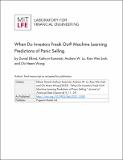| dc.contributor.author | Elkind, Daniel | |
| dc.contributor.author | Kaminski, Kathryn | |
| dc.contributor.author | Lo, Andrew W. | |
| dc.contributor.author | Siah, Kien Wei | |
| dc.contributor.author | Wong, Chi Heem | |
| dc.date.accessioned | 2022-04-06T16:18:59Z | |
| dc.date.available | 2022-04-06T16:18:59Z | |
| dc.date.issued | 2022 | |
| dc.identifier.uri | https://hdl.handle.net/1721.1/141712 | |
| dc.description.abstract | Using a novel dataset of 653,455 individual brokerage accounts belonging to 298,556 households, we document the frequency, timing, and duration of panic sales, which we define as a decline of 90% of a household account’s equity assets over the course of one month, of which 50% or more is due to trades. We find that a disproportionate number of households make panic sales when there are sharp market downturns, a phenomenon we call ‘freaking out.’
We show that panic selling and freak-outs are predictable and fundamentally different from other well-known behavioral patterns such as overtrading or the disposition effect. | en_US |
| dc.language.iso | en_US | en_US |
| dc.publisher | Journal of Financial Data Science | en_US |
| dc.subject | deep learning, freaking out, panic selling, stop-loss, tactical asset allocation | en_US |
| dc.title | When Do Investors Freak Out? Machine Learning Predictions of Panic Selling | en_US |
| dc.type | Article | en_US |
| dc.identifier.citation | Elkind, Daniel, Kathryn Kaminski, Andrew W. Lo, Kien Wei Siah, and Chi Heem Wong. “When Do Investors Freak Out? Machine Learning Predictions of Panic Selling.” Journal of Financial Data Science 4(1), 11–39. | en_US |
| dc.contributor.department | Sloan School of Management. Laboratory for Financial Engineering | |
| dc.contributor.department | Sloan School of Management | |
